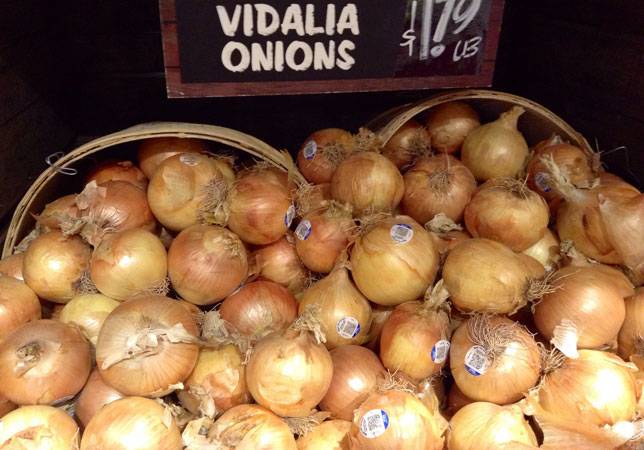
Photo: Mike Mozart/flickr
Vidalia Onion: Half the Crop Grown in Tattnall
Arguably Georgia's most famous agricultural product, the sweet Vidalia Onion has its roots deep in Tattnall County's soil with more than half the annual crop coming from our county and the nation's largest grower, packer and shipper of sweet onions headquartered in Glennville. We can also claim credit for the first and now oldest sweet onion festival in Georgia, the Glennville Sweet Onion Festival.
By Tom Oder, reprinted from the Mother Nature Network
Like many of life's great finds, the Vidalia onion was discovered by accident. The story begins in 1931 when an unsuspecting farmer planted sweet onions instead of hot onions in the sandy fields of his farm in Southeast Georgia's Toombs County.
When the farmer, Moses Coleman, realized how much people liked the onions' distinct flavor, he raised the price to $3.50 a bag, a higher-than-normal price during those Depression era years. Other farmers took notice. Soon they were growing and selling these sweet onions, too.
The sweet onions remained a mostly local secret until the 1940s. In that decade, according to the University of Georgia, Earle Jordan planted the yellow granex onion, a hybrid of the Bermuda and Grano onions developed by Henry Jones of Texas A&M. It was this onion that eventually became the famous Vidalia onion.
This was before interstate highways were built, when salesmen, families and travelers drove back roads to get from town to town or state to state. Vidalia was at the crossroads of these types of roads, which were among the busiest of their kind in South Georgia. The little town was also almost dead center among the bustling cities of Macon, Augusta and Savannah.
In Atlanta, the state government realized that the local onion farmers were on to something. So in 1949, government officials decided to build a farmers market at the intersection of the Vidalia crossroads to help promote and sell the onions to people passing through. Customers started calling the local specialty "Vidalia onions," and the name stuck.
After the war years, production grew steadily, encompassing 600 acres by the end of the 1960s. In 1963, according to UGA, the Piggly Wiggly supermarket chain gave the onions possibly their biggest boost. Gary Achenbach (president of Piggly Wiggly Southern in Vidalia) and also an onion grower and Wall Street adviser, built a produce distribution center in Vidalia. Achenbach provided marketing expertise that helped get the onions into Piggly Wigglys throughout the Southeast. Other retail outlets caught onto this success and started shipping Vidalia onions into other parts of the country.
In the early 1970s, two onion growers, Danny and David New, led an effort to unite the marketing of the onions and pushed for a common name, the Vidalia sweet onion. During this time, the success of other area onion farmers led to another sweet onion getting its own name, the Glennville sweet onion. This onion was named after a town in Tattnall County, about 35 miles southeast of Vidalia.
In 1977, Glennville had what would become an annual onion festival. A year later, Vidalia had its first festival. The festivals became an annual tradition that continues today.
By the mid-1980s, the onion farmers realized they needed to protect their brand. One of the ways they did that was to form cooperatives to assist in marketing and to keep bootleggers from rebagging onions from other states and selling them as Vidalias. The growers also realized that there was another problem: confusion about what constituted a genuine Vidalia or a Glennville sweet onion. To end the confusion, they decided to work together to settle on one product and promote it with one voice.
Local UGA extension agents coordinated regional meetings in 1985 to respond to the growers' needs. These meetings included the U.S. Department of Agriculture, the Georgia Department of Agriculture, and UGA personnel. As a result of these meetings, the growers, among other things, agreed to the Vidalia name and to seek legal protection of their valuable commodity.
The next year, the Georgia General Assembly passed the Vidalia Onion Act of 1986. The act defined 13 counties — Emanuel, Candler, Treutlen, Bulloch, Wheeler, Montgomery, Evans, Tattnall, Toombs, Telfair, Jeff Davis, Appling and Bacon — and parts of seven other counties — Jenkins, Screven, Laurens, Dodge, Pierce, Wayne and Long — as the official growing area for Vidalia onions. Importantly, it also granted ownership of the Vidalia onion name to the state Department of Agriculture. To earn the right to be called a Vidalia, the act stipulated that the onions must be grown in the region, as opposed to being grown elsewhere and brought to the region for packing and shipping, and must be varieties of Allium Cepa of the hybrid yellow granex, granex parentage or other similar varieties.
In 1989, the U.S. Department of Agriculture provided federal protection to the Vidalia onion. The USDA also created the Vidalia Onion Committee, which supports both marketing and research initiatives for Vidalia onions. In 1990, Vidalia onion production quadrupled and the General Assembly passed legislation declaring the Vidalia onion the official Georgia vegetable. Then, finally, in 1992 the state of Georgia became the official owner of the Vidalia onion trademark.
Today, Vidalia onions are a vital part of Georgia's economy. Well more than 12,000 acres of the onions are grown annually, which constitutes about 40 percent of the nation's spring onion production. No longer just a Southern thing, they are available in 50 states and most of Canada.
In 1999, the 142-acre UGA College of Agriculture and Environmental Sciences Vidalia Onion and Vegetable Research Center opened in Toombs County. The center focuses on commercial vegetable production issues for a variety of crops, ranging from artichokes to watermelon, with 14 acres devoted to Vidalia onions. The center expanded in 2008, and in 2013, the Vidalia Onion Committee reached the $1 million mark in research contributions supporting the research center.
To ensure quality and protect brand identity, farmers who want to grow under the Vidalia umbrella must register with the state and keep the agriculture commissioner aware of what varieties they are growing. They also can't sell their onions until a date that the commissioner determines, which is the source of the current legal controversy.
What makes them sweet?
What gives Vidalia onions their sweet taste? Three things, according to the Vidalia Onion Committee, which was established with the federal marketing order to promote Vidalia onions. A perfect storm of weather, water and soil: Winters are mild in the region with few prolonged freezes; there is a combination of regular rainfall and ready access to irrigation during periodic dry spells; and the soil in the area is low in sulfur.
Seed of the short-day yellow granex variety of onion, which is the only variety of onion that meets the legal definition of a Vidalia onion, will only grow in regions where the winter days are short and mild. Regular moisture is especially critical according to the committee's website, because it is the high water content rather than a high acid content that gives the onions their mild, sweet taste.
By contrast, onions grown in soil high in sulfur compounds tend to have a hot, bitter flavor derived from the sulfur. It's these compounds that cause people to cry when they slice into an onion. Cutting the onion releases enzymes that break down the sulfur compounds and generate unstable chemicals called sulfenic acids. These acids, once released, turn into a volatile, airborne gas called sulfuric acid that drifts into the eyes.
The only time that Vidalias make you cry, say the people who look forward to them every year, is when they're all gone and you have to wait for next year's crop to hit the store shelves.
When are they available?
Georgia's state vegetable is planted in the fall and is available in grocery stores nationwide the next year from late April to mid September.
A technology developed by UGA horticulturalist Doyle A. Smittle called controlled atmosphere (CA) storage that Vidalia onion growers borrowed in the early 1990s from Georgia's apple industry greatly expanded the length of time the onions can be sold. CA storage allows for Vidalia onions to be kept fresh for up to seven months. About 125 million pounds of Vidalia onions are put into CA storage each year.
Recipes and uses
The Vidalia Onion Committee’s website list numerous recipes and uses for Vidalia onions.
A popular way to cook them is the grill them. A simple grilling method is to peel them and wrap them in foil like a baked potato. Or, you can get "fancy" and cut a small hole in the top of the core, put in a beef bullion cube and a pat of butter, replace the core, wrap in foil and then grill.
If you can't find Vidalia onions in a nearby store, you can order them by mail. A list of licensed growers is available on the committee's website.
